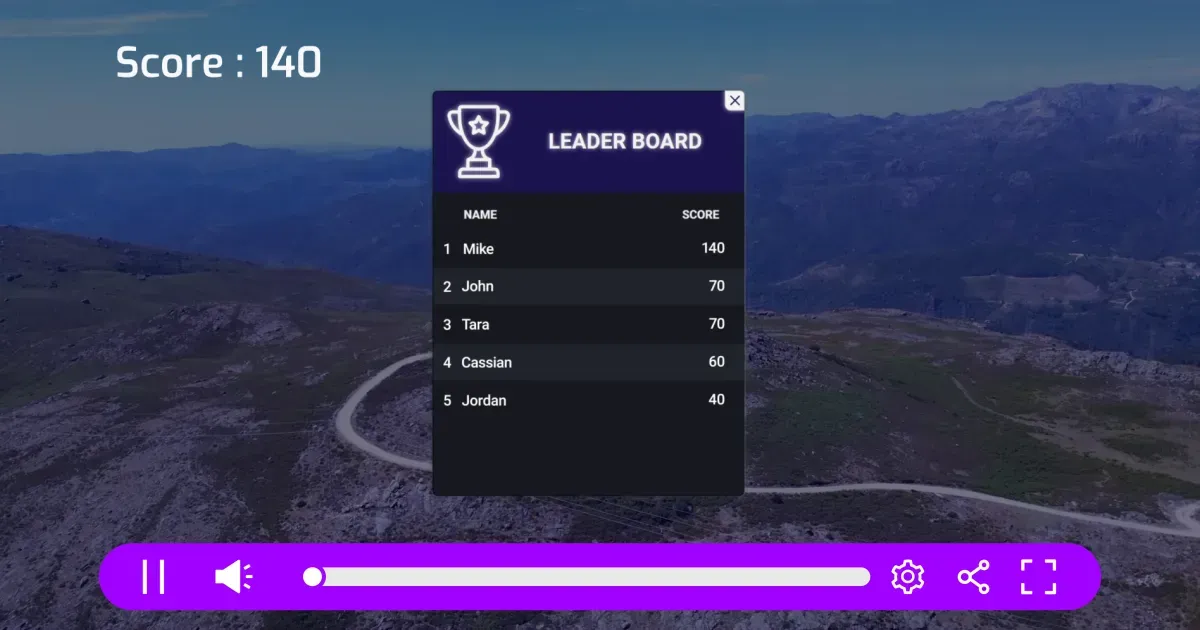Enterprise learning is shifting towards more personalised, data-driven methods and video is at the centre of this change. As learning and development (L&D) teams look to improve training outcomes, interactive video offers a way to engage employees at scale, support different learning styles, and adapt to individual progress.
Unlike static video formats, interactive video is an engaging e-learning video format that enables employees to explore topics at their own pace, revisit key lessons, and stay aligned with enterprise training goals. Whether delivered through a learning management system, hosted on an e-learning platform, or embedded into daily workflows, this format supports everything from onboarding to employee upskilling.
In this guide, we’ll explore how interactive video helps elevate corporate training programmes and improve learning and development across the enterprise.
What is enterprise learning and why does it matter?
Enterprise learning, also known as corporate training, refers to the strategic approach organisations take to train and upskill employees at scale. It goes beyond one-off training sessions or onboarding materials and is about building a culture of growth that aligns with business goals and supports career development.
This type of learning typically includes structured programmes delivered through learning management systems, self-paced digital courses, in-person sessions, or blended formats. The goal is to provide scalable, role-specific training that equips teams with the skills they need to succeed now and adapt in the future. When done well, enterprise learning improves employee engagement, boosts retention, and builds long-term organisational capability.

The impact of interactive video on employee training
Interactive video turns employee training into a two-way experience by ensuring employees engage directly with the content. They can do this by clicking through scenarios, answering questions, and receiving instant feedback. This type of active enterprise learning drives higher attention, better recall, and deeper understanding.
Unlike static formats such as PDFs and slide decks, or even traditional video formats, interactive videos adapt to different learning styles and allow users to control their pace. You can build in video branching logic, real-world simulations, or decision points that make the experience more personalised and practical.
The result? More effective training that’s engaging and opens up the opportunity for more measurable results.
Key benefits of using interactive video for enterprise training
Video has become one of the most effective formats for enterprise training because it balances flexibility, engagement, and scalability. It can be used for onboarding, compliance, and continuous learning, and makes it easier to deliver consistent, high-impact training across teams and locations. Add an interactive element, and you can further improve training outcomes.
Benefits of using interactive video in enterprise learning include:
- On-demand access: Employees can learn at their own pace, revisit content as needed, and fit training into their schedules.
- Stronger retention: Visual and auditory elements help reinforce key concepts and improve knowledge retention while participation further strengthens these benefits.
- Scalable delivery: One video can train hundreds or thousands of employees–no need for repeated live sessions.
- Personalised experiences: Videos can be tailored by role, department, or learning objective, ensuring relevance. Some interactive video platforms even allow hyper-personalisation to the individual viewer.
- Support for different learning styles: Combines audio, visual, and hands-on interaction for broader appeal.
- Trackable progress: With the right tools, teams can monitor completion, engagement, and learning outcomes.
- Higher engagement: Compared to static documents and traditional video formats, interactive video content is more likely to hold attention and drive action.

How to create interactive learning videos for corporate teams
Creating effective interactive training videos involves an effective structure, targeted relevance, and intentional design. Whether you’re building compliance walkthroughs, onboarding materials, or upskilling modules, the goal is to guide employees through an engaging, self-directed learning experience that delivers real value.
From choosing a focused topic to refining your final video based on feedback, each step in the process plays a crucial role in achieving enterprise training goals and supporting long-term development.
Choose the right topic for your enterprise training video
A successful enterprise training video starts with a topic that’s relevant to your audience. Focus on real knowledge gaps or skills that need refreshing. This may include systems training, compliance, soft skills, or anything else that aligns with your corporate training goals. The more targeted the subject, the more engaging and effective your video will be.
If your goal is employee upskilling, identify areas where new capabilities will drive business value. Use performance reviews, onboarding feedback, or support data to shape your content. And keep each video focused on a single topic. This helps your team absorb the material more easily and makes it easier to repurpose the video later.
Pick the best format for your employee training goals
The format you choose should match the complexity of the topic and your team’s learning preferences. For quick refreshers or onboarding steps, microlearning videos work well because they’re short, focused, and easy to revisit. For deeper training, screencasts and scenario-based videos provide more context and interactivity.
Interactive video adds another layer by letting employees engage directly with the content through clickable paths, quizzes and gamified elements, or embedded decision-making. This format is especially useful for enterprise training where engagement and retention are key. By tailoring the format to your training goals, you make it easier for employees to connect with the material and apply what they’ve learned.
Script and storyboard your video content
A strong script is the foundation of any effective employee training video. Start by outlining your key learning objectives, then structure your message clearly–keeping language simple, conversational, and aligned with your tone of voice. If you’re using interactive elements like branching or quizzes, plan where they’ll appear in the viewer journey.
Once your script is final, create a storyboard to map out each scene visually. This doesn’t need to be overly detailed. Basic sketches or notes can help clarify how the video will flow, where visuals and interactivity sit, and how the narrative builds. For enterprise learning, this step ensures the end result is informative, engaging, and on-brand.
Record and edit your enterprise learning video
Once your script and storyboard are ready, it’s time to bring your enterprise learning content to life. Use a screen recorder or camera setup that fits your format. For enterprise teams, keeping things professional and consistent with brand guidelines is key, even if you're using simple tools.
As you edit your video, focus on clarity and pacing. Cut out unnecessary pauses, add captions, and include interactive elements like buttons, quizzes, or branching prompts at key moments. Platforms like Cinema8 allow you to do this seamlessly while keeping the experience smooth for the viewer. The goal is a clean, polished training video that encourages active participation and can scale across teams.
Review feedback and refine for long-term use
Once your interactive video is complete, don’t treat it as a finished product. Rather, gather feedback from employees through surveys or direct comments and use this feedback to guide improvements. Look at how users interact with the content: where they stop watching, what they click on, and which parts of your video they revisit.
This feedback, combined with performance data like engagement and completion rates, will highlight what’s working and what’s not. Regular updates keep your enterprise learning content relevant and effective.

Why video supports long-term learning and development goals
Long-term employee development requires tools that make learning accessible, repeatable, and relevant over time. Video (especially when interactive) gives teams the ability to revisit training content whenever they need a refresh, helping knowledge stick and evolve with changing roles.
Interactive video takes this further by adapting to learners’ needs and supporting continuous upskilling while providing insight into progress. Over time, this creates a culture of learning that grows with your organisation, rather than fading after a single session. For enterprise teams focused on sustainable development, video delivers lasting impact without reinventing the wheel for every new hire or process update.
Final thoughts on scaling enterprise learning with interactive video
As enterprise teams grow, so do the challenges of delivering consistent, high-quality enterprise learning. Interactive video provides a scalable way to meet those challenges and equips employees with flexible, personalised learning experiences that adapt over time.
From onboarding and compliance to upskilling and leadership development, video lets you train at scale without sacrificing engagement or quality. And with built-in analytics, every interaction becomes an opportunity to measure effectiveness and improve outcomes.
For organisations ready to scale learning in smarter ways, interactive video is a strategic tool for continuous development. With platforms like Cinema8, which support SCORM and LTI integrations, it’s easier than ever to create, manage, and optimise enterprise learning experiences that deliver long-term value.
